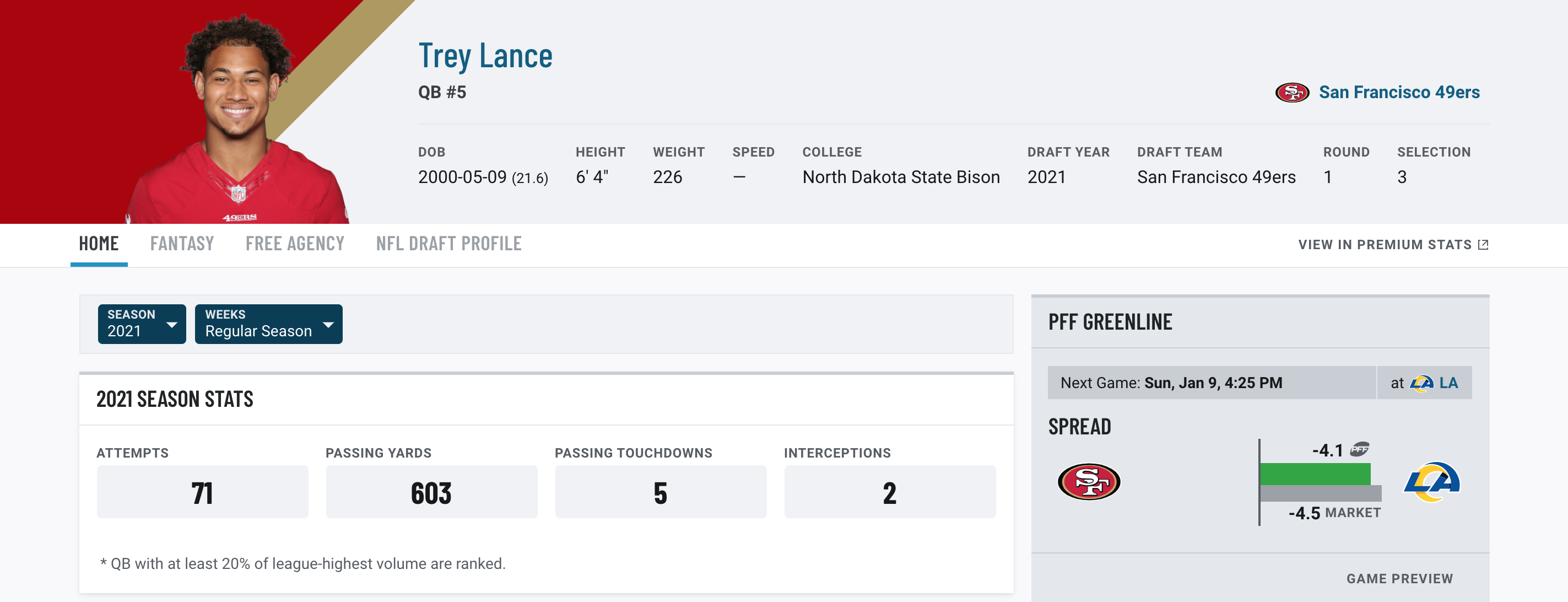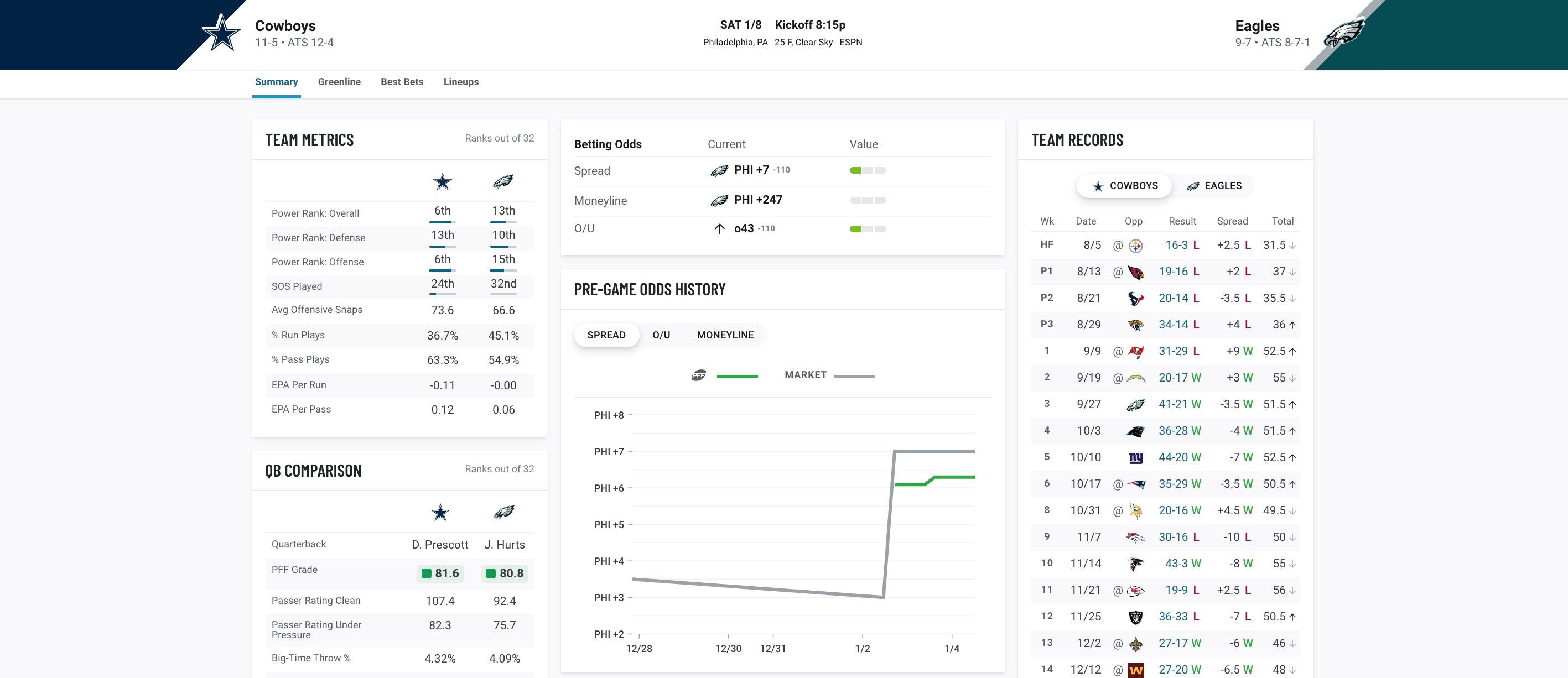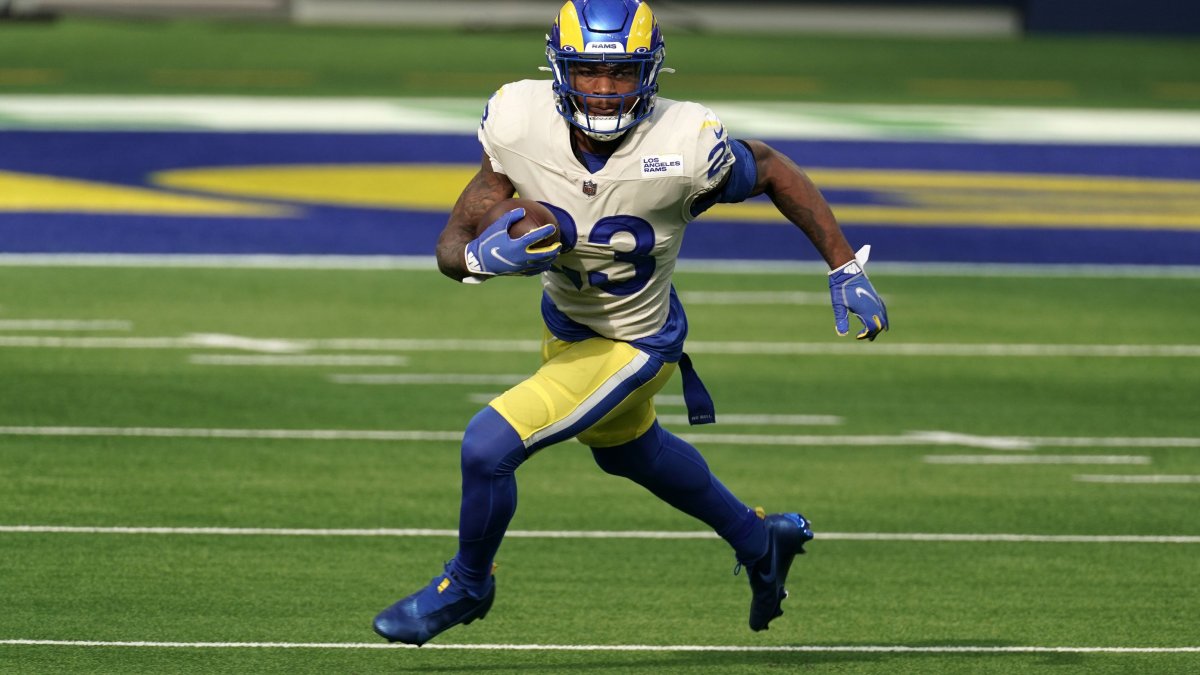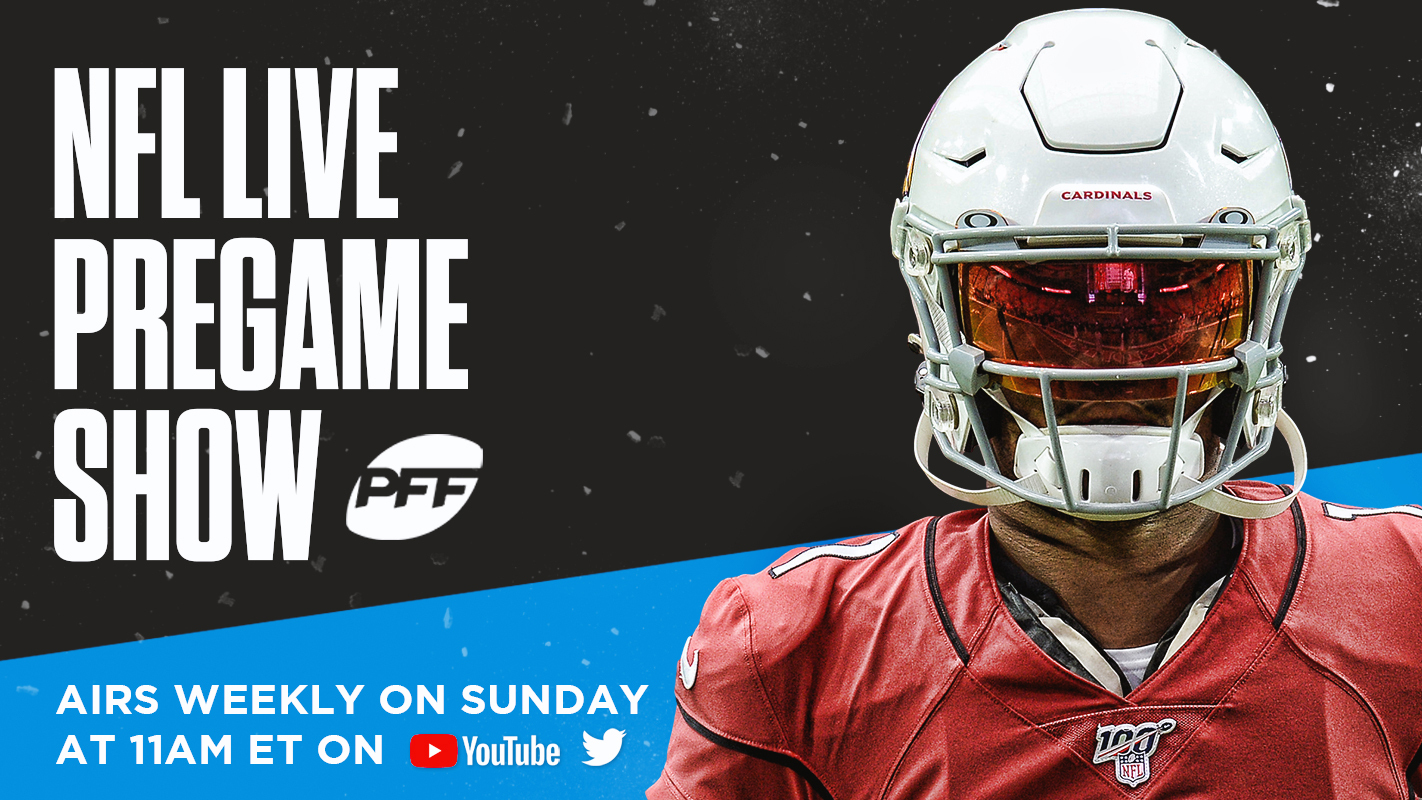A lot of cool stuff happened in the 2021 fantasy football season that we didn’t necessarily see coming this time last year. A few examples:
- Cooper Kupp took home fantasy MVP honors on the back of one of the most productive seasons the position has ever seen. We all knew Kupp was good, but Jerry Rice good? Madness.
- Ja’Marr Chase joined former LSU teammate Justin Jefferson as a rookie receiver so damn good that he’s already in the conversation surrounding the league’s top-10 players at the position regardless of experience.
- Cordarrelle Patterson decided that his ninth year in the NFL would be his best, racking up 11 total touchdowns on offense — as many as he had in 2014-2020 combined.
- Mark Andrews snapped Travis Kelce’s five-year run as fantasy king of the tight ends despite spending the final month of the season catching passes from Tyler Huntley and Josh Johnson.
Show me anyone who saw all four of these events coming, and I’ll show you a liar (but maybe ask them about what Bitcoin looks like in 2023 just to be safe). Still, the former three events did include a major personnel change of sorts, while the latter was built on the Ravens finally embracing something more closely resembling a pass-oriented attack for the first time in the Lamar Jackson era.
What follows are my top-10 fantasy storylines to follow throughout the offseason that might just define the 2022 season, listed in no particular order. These will be primarily based on potential player movement and guys taking a huge leap forward; ultimately, we’re just trying to take an early gander at what the entire industry will be freaking out about during the summer.
Click here for more PFF tools:
Rankings & Projections | WR/CB Matchup Chart | NFL & NCAA Betting Dashboards | NFL Player Props Tool | NFL & NCAA Power Rankings
Best Bets Tool
1. Is Cam Akers going to get his job back?
The Rams’ starting running back has been a borderline fantasy cheat code during the Sean McVay era:
- 2017: Todd Gurley finishes as the overall PPR RB1.
- 2018: Gurley finishes as the overall RB3 despite missing the final two games of the season. Don’t worry: C.J. Anderson exploded for 20-167-1 and 23-132-1 rushing lines during Gurley’s two-week sabbatical.
- 2019: Gurley posts RB14 production despite looking like a shell of his former self for most of the season. That’s what 14 total touchdowns — none of which were longer than 13 yards — can do for a man.
- 2020: Finally, McVay utilizes a somewhat consistent committee between Malcolm Brown, Darrell Henderson and Cam Akers, although the latter back broke out enough to post PPR RB16, RB13 and RB10 finishes in three non-injury-induced starts from Weeks 12-14.
- 2021: Henderson seized the starting job with Akers (Achilles, IR) sidelined for the season, ultimately working as the PPR RB12 in Weeks 1-10 before the Rams’ bye. Late-season injury woes prevented Henderson from keeping on, but that did open up the door for ex-Patriots talent Sony Michel to work as the RB10 in Weeks 12-17.
The primary reason for this consistent high-end production revolves solely around volume. Gurley surpassed the 300-touch mark with ease in 2017 and 2018 while regularly posting snap rates north of 90%. The latter point is something that also came to fruition for each of Anderson, Akers, Henderson and Michel at one point over the years; Sean McVay loves himself a true three-down back during an era in which most offenses are trending toward multiplayer committees.
Akers’ speedy recovery from his Achilles injury could have him suiting up for playoff football; the bigger question in fantasy land is whether or not he’ll be asked to once again function as this offense’s undisputed lead back. McVay said last offseason that there are no “limitations” on how the Rams can use Akers; we’ll see if that attitude holds with the 22-year-old talent coming off arguably the single-most debilitating injury that a running back can suffer.
Volume is king in fantasy land. Each of Akers, Michel and Henderson have proven capable of providing RB1 production when leaned on as this offense’s starter, but a committee of sorts could render each as non-viable fantasy options more weeks than not. It sure seems likely that McVay will decide on a featured back at some point — that’s his thing, after all — and that player will undoubtedly skyrocket up fantasy draft boards of all shapes and sizes.
2. Are the Bills going old or young at wide receiver?
Josh Allen ranks sixth in passing yards (8.712) and fourth in passing touchdowns (71) over the past two seasons while orchestrating the league’s fourth-most pass-heavy attack in non-garbage time situations. It’s a good time to be a pass-catcher in Buffalo.
Obviously Stefon Diggs isn’t going anywhere, and the Bills figure to lean on Dawson Knox for at least another year through the end of his rookie contract. However, the team can save $6.1 million against the cap by parting ways with Cole Beasley at any point during the offseason. Plus, Emmanuel Sanders only signed a one-year contract back in March.
It’s not like Beasley and Sanders are completely washed, but they’ll be 33 and 35 years old, respectively, when next season comes around. Every penny counts when your quarterback is making $258 million.
There’s also the reality that the Bills might just already have two tailor-made improvements on this very roster. Gabriel Davis is on the squad through 2023 and finished second to only Diggs in PFF receiving grade and yards per route run among all Bills receivers. Isaiah McKenzie will be a free agent himself but figures to come back at a more affordable price than either Beasley or Sanders. Credit to the 26-year-old talent for ripping off electrifying 6-65-2 and 11-125-1 receiving performances in the only two games he’s been leaned on since 2020.
There’s more than enough pass-game volume in this offense to enable multiple high-end fantasy options; monitor this depth chart throughout the offseason and be ready to pounce in best ball drafts of all shapes and sizes once we figure out who is staying and who is leaving.
3. Which second-year quarterback will emerge as the most fantasy-friendly option?
There have been plenty of stud second-year fantasy quarterbacks in recent years:
- 2021: Justin Herbert (QB3), Joe Burrow (QB5) and Jalen Hurts (QB8) each emerged with consistent floors to go along with week-winning upside.
- 2020: Kyler Murray (QB2) took the next step forward after an already-solid rookie campaign and was on pace to vie for the position’s all-time best fantasy season before suffering a midseason shoulder injury.
- 2019: Lamar Jackson (QB1) ripped off the highest-scoring season by a quarterback in NFL history on a per-game basis (27.7 fantasy points per game) in style, while Josh Allen (QB6) also proved to be a more than viable high-end QB1.
- 2018: Patrick Mahomes (QB1) ripped off the highest-scoring season by a quarterback in NFL history overall (417.1 fantasy points) in style, while Deshaun Watson (QB4) also proved his borderline erotic short time under center as a rookie was no fluke.
The intriguing part about this trend is the reality that several of these quarterbacks weren’t overly expensive to draft. None of Herbert (ADP QB8), Hurts (QB12) or Burrow (QB13) required an early-round pick to acquire, while Jackson (QB14) and Mahomes (QB16) were true late-round darlings before exploding onto the scene.
The industry seems more acutely aware than ever that dual-threat quarterbacks offer one of the highest floor/ceiling combinations in all of fantasy, but the respective struggles from Trevor Lawrence, Zach Wilson, Trey Lance, Justin Fields and Mac Jones (at least from a fantasy perspective) figures to lead to somewhat reduced 2022 expectations.

Resident PFF ranking expert Nathan Jahnke’s early 2022 top-250 fantasy rankings pits Lance (QB10) as the front-runner, with Jones (QB16), Fields (QB19), Lawrence (QB21) and Wilson (QB25) pulling up the rear. Lance and Fields did prove capable of providing true QB1 upside during their stints under center, while Jones, Lawrence and Wilson are cheap enough to at least be solid late-round darts in fantasy formats of all shapes and sizes.
There’s still a lot to be unwrapped regarding each quarterback’s respective depth chart, play-caller and roster; just realize history tells us that at least one of these second-year talents figures to leap into the upper hierarchy of fantasy quarterback performance, and each looks like he could feasibly be had at a plenty reasonable cost.
4. Which star NFL quarterbacks will be traded?
Three objectively stud quarterbacks have been the focus on trade rumors for the better part of the last 12 months: Aaron Rodgers, Russell Wilson and Deshaun Watson. Each could easily simply return to his current team considering 1.) it’s not a given the Packers or Seahawks decide to part ways with their long-time franchise quarterbacks, and 2.) Watson’s legal issues complicate the entire situation.
Still, there’s little doubt that Rodgers, Wilson and Watson are capable of elevating pretty much any offense in the league on the field if given the opportunity. Their respective departures might doom their current offenses, but the following four teams could suddenly boast a plethora of high-end fantasy options if they’re able to acquire one of these high-end quarterbacks:
- Denver Broncos: Whoever is under center next season will get to throw the ball to Jerry Jeudy, Courtland Sutton, Tim Patrick, K.J. Hamler, Noah Fant, Albert Okwuegbunam and Javonte Williams. Neither Teddy Bridgewater nor Drew Lock managed to make it work in 2022, but it’s easy to imagine a Peyton-esque leap from every skill-position player involved if the Broncos can land one of the quarterback position’s big fish.
- Carolina Panthers: D.J. Moore is far too good to be subjected to piss-poor quarterback play for another season. Nobody had more incompletions sent his way that were deemed to be the quarterback’s fault. PFF’s bottom-two skill-position players in fantasy points below expectation: Moore and Robby Anderson. Reminder: Both Moore (66-1,193-4) and Anderson (95-1,096-3) largely balled out in 2020 despite having to deal with Bridgewater under center. Throw in the presence of all-world RB Christian McCaffrey and 2021 second-round pick Terrace Marshall and one can easily understand why upgrading from Sam Darnold could be good for everyone involved.
- New Orleans Saints: There’s a dropoff in overall weaponry here, but peppering Alvin Kamara and Michael Thomas with targets sure didn’t stop a noodle-armed version of Drew Brees from obtaining plenty of late-career fantasy success. The fact that Sean Payton has still enabled the league’s 19th-ranked scoring offense despite dealing with all kinds of issues at quarterback in 2021 seems like a minor miracle; betting against a pairing featuring one of the game’s best offensive minds with any of Rodgers, Wilson or Watson seems like a bad idea.
- Pittsburgh Steelers: Ben Roethlisberger’s 123 passing yards on 46 attempts in his Week 17 sendoff from Heinz Field demonstrated what this passing game has been forced to deal with all season long. Yet, Diontae Johnson (88-923-7 in 2020, 100-1,110-8 in 2021) has emerged as a legit No. 1 receiver, and Chase Claypool is one season removed from scoring 13 touchdowns as a rookie (including playoffs). Throw in potential second-year leaps from RB Najee Harris and TE Pat Friermuth, and it’d be hard to call the Steelers anything other than Super Bowl contenders with a serious upgrade at quarterback.
5. Will wide receivers leap running backs in terms of whom the public prioritizes in the early rounds of fantasy drafts?
Fewer running backs have finished as top-24 producers among all skill-position players in 2020-2021 than fantasy football has seen since 2013-2015:
| Top-24 | RB | TE | WR |
| 2021 | 8 | 2 | 14 |
| 2020 | 8 | 2 | 14 |
| 2019 | 12 | 1 | 11 |
| 2018 | 9 | 3 | 12 |
| 2017 | 10 | 2 | 12 |
| 2016 | 10 | 0 | 14 |
| 2015 | 5 | 4 | 15 |
| 2014 | 8 | 2 | 14 |
| 2013 | 8 | 1 | 15 |
| 2012 | 9 | 0 | 15 |
Looking at top-12 finishes tells a similar story: Wide receivers have generally made up the bulk of fantasy’s top-overall performers over the years.
| Top-12 | RB | TE | WR |
| 2021 | 4 | 1 | 7 |
| 2020 | 3 | 2 | 7 |
| 2019 | 6 | 0 | 6 |
| 2018 | 5 | 0 | 7 |
| 2017 | 7 | 0 | 5 |
| 2016 | 6 | 0 | 6 |
| 2015 | 1 | 0 | 11 |
| 2014 | 4 | 0 | 8 |
| 2013 | 4 | 1 | 7 |
| 2012 | 5 | 0 | 7 |
A general rule of thumb in fantasy: Don’t hate players, hate average draft position (ADP). Zero-RB zealots figure to be out in full force during the offseason pointing to numbers like the charts above; just realize every season and correspondingly fantasy draft is different. What worked in 2021 won’t be the exact correct strategy for how to approach 2022; be on the lookout for overcorrections, and do your best to focus more on what we expect to happen next season instead of reflecting on the past.
6. Will the Broncos bring back Melvin Gordon?
There arguably wasn’t a more impressive back in all of football on a per-touch basis than Javonte Williams, who averaged a league-high 0.31 missed forced tackles per carry and ranked sixth in yards after contact per rush (3.4). The rookie did so in style.
Free Javonte Williams pic.twitter.com/Pa4ZMhuenY
— Ian Hartitz (@Ihartitz) November 30, 2021
Of course, Williams didn’t exactly take over in fantasy land, finishing as the RB25 in PPR points per game. This was one spot ahead of teammate Melvin Gordon, who is an unrestricted free agent in 2022.
All Williams did during Gordon’s one missed game was post 23-102-0 rushing and 6-76-1 receiving lines on his way to functioning as the week’s overall RB1. Yes, plenty of that production occurred in garbage time. Also yes, style points don’t matter in fantasy land; these are the sort of performances that great players can post in spite of bad offenses when given a true three-down role.
There’s a scenario where Williams begins to flirt with the position’s top-five players if 1.) Gordon doesn’t return, 2.) the Broncos don’t add a higher-end backup, and 3.) one of Aaron Rodgers, Russell Wilson or Deshaun Watson find their way to Denver. Of course, the return of Gordon and/or addition of a fellow high-round/priced back could render Williams back to borderline RB2 status despite his obvious talents. Williams and Gordon literally tied each other with 191 carries through the first 16 weeks of 2021; it’s tough for anybody to work as a consistent fantasy RB1 with this sort of split usage.
7. What will the Cowboys’ wide receiver room look like come May?
Obviously CeeDee Lamb is the Cowboys’ alpha No. 1 receiver of the present and future, but things are a bit more complicated behind him. Dak Prescott and the Cowboys’ top-ranked scoring offense are certainly a group that should be able to enable multiple high-end fantasy receivers; it’s just unclear who will be at his disposal in 2022.
- It’ll be tough for the Cowboys to get out of Ezekiel Elliott’s contract before 2023 at the earliest, but they could save $20 million against the cap and only eat $2 million in dead money by releasing Amari Cooper after June 1 (per Over The Cap). Cooper will still only be 28 come Week 1 of next season, although he was banged up for much of 2021 and posted three-year lows in PFF receiving grade (72.9) and yards per route run (1.51).
- Michael Gallup (ACL) figured to have a competitive market before getting injured in Week 17, but perhaps the Cowboys will be able to bring back the unrestricted free agent at a discount.
- No. 4 receiver Cedrick Wilson joines Gallup as an unrestricted free agent after the season. This is also true for No. 5 receiver Noah Brown and even sporadic 2021 contributor Malik Turner.
Add it all together: Lamb is literally the only wide receiver who has played a snap for the Cowboys this season and is guaranteed to be back in Dallas. Obviously it’s not a guarantee that any/all of the other receivers will take their talents elsewhere; just realize it was already going to be hard to keep Lamb outside of the position’s top-five options, and that point will be doubly true if he’s looking at one of the largest workloads of any player in the league.

8. Are the Eagles and Dolphins content with their current situations under center?
Neither team qualified as an exceptional landing spot for our aforementioned big-three quarterbacks that could completely shift any given offense for the better, but that doesn’t mean there wouldn’t be some serious fantasy ramifications if either the Eagles or Dolphins decide to move on from Jalen Hurts or Tua Tagovailoa.
In Hurts’ case: He’s a high-floor QB1 thanks to one of the largest rushing workloads the position has ever seen. Overall, Hurts’ 139 rush attempts are the fifth-most in a single season by a quarterback in NFL history; just nine more carries will leave him behind only 2019 and 2020 Lamar Jackson. This is obviously great for Hurts’ personal fantasy value, but moving on would probably lead to more consistent volume for the likes of DeVonta Smith and Dallas Goedert, while historically dual-threat quarterbacks haven’t enabled high-end fantasy running backs.
In Tua’s case: He’s not much more than a low-ceiling QB2 (as evidenced by his standing as the QB24 in fantasy points per game in 2021), but his willingness to feed Jaylen Waddle the 11th-most targets in the league (133) might not be replicated with a more aggressive quarterback under center. It’s certainly possible having healthier versions of DeVante Parker and Will Fuller, as well as even a mediocre offensive line, could also depress Waddle’s outrageous volume.
9. Where will the top wide receiver free agents go?
Historically, wide receivers have proven capable of posting high-end fantasy production into their second contracts, while the majority of running backs have fallen off hard following their third or fourth year in the league. Most free agent receivers inked to contracts paying north of $10 million per year have (understandably) at least functioned as top-two receivers in their passing games.
The following unrestricted free agents certainly seem like viable contenders to land a contract worthy of a starting spot in the 2022 offseason if their current employer decides to part ways with them:
- Davante Adams: Don’t get too excited — Green Bay is reportedly going to franchise tag their start receiver.
- Chris Godwin and Michael Gallup: Obviously the former receiver has proven a bit more than the latter over the years; just realize both are probably more likely to return to the their present employers after suffering late-season ACL injuries.
- Allen Robinson: The 28-year-old receiver has come back from bad seasons before; there figure to be plenty of suitors willing to at least give a one-year trial deal to the man only one year removed from a 102-1,250-6 campaign.
- Will Fuller: Played just 65 total snaps in 2021; just realize all 32 offenses are better off with his high-end field-stretching ability.
- JuJu Smith-Schuster: Reportedly received plenty of interest from the Chiefs last offseason. Still just 25 years old, it’s too early to completely rule something close to a return to form within a better offense.
- Mike Williams: Scored 10 touchdowns in 2018, went for over 1,000 yards in 2019 and put forward a career-best 67-1,027-8 campaign through 17 weeks of 2021. The former No. 7 overall pick has the sort of pedigree and proven production to likely give him the opportunity to slide in as the No. 2 receiver in more than a handful of offenses around the league.
- Antonio Brown: Hey man, who knows. The latest hoopla sure seems likely to end AB’s time in Tampa Bay; just realize the 33-year-old receiver largely looked better than ever *on the field* in 2021 on his way to averaging a robust 2.79 yards per route run — the fourth-highest mark among all wide receivers.
10. Which rooks will turn out to be high-end fantasy producers in year one?
I won’t pretend to have a major grip on the upcoming rookie class just yet, but that’s what PFF’s 2022 NFL Draft Guide is for.




 © 2025 PFF - all rights reserved.
© 2025 PFF - all rights reserved.